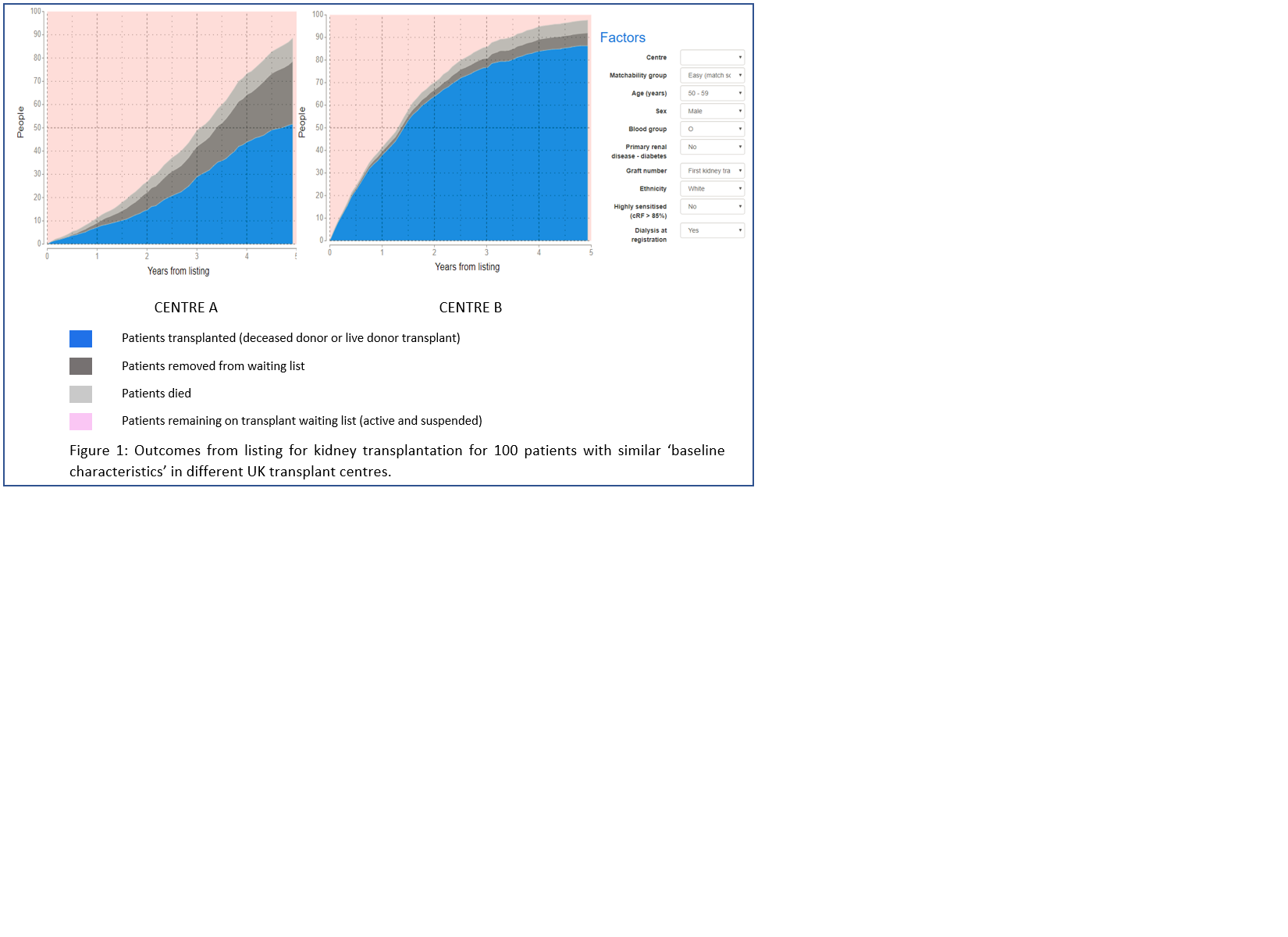Modelling Patient Outcomes after Listing for Deceased Donor Kidney Transplantation in the UK: A Novel Technique
1Statistics and Clinical Studies, NHS Blood and Transplant, Bristol, United Kingdom, 2Winton Centre for Risk Evidence and Communication, Cambridge, United Kingdom, 3NHS Blood and Transplant, Bristol, United Kingdom, 4Renal, Guy's and St Thomas' NHS Trust, London, United Kingdom
Meeting: 2020 American Transplant Congress
Abstract number: 266
Keywords: Cadaveric organs, Kidney transplantation, Prognosis, Risk factors
Session Information
Session Name: All Organs: Disparities to Outcome and Access to Healthcare I
Session Type: Oral Abstract Session
Date: Saturday, May 30, 2020
Session Time: 3:15pm-4:45pm
 Presentation Time: 3:39pm-3:51pm
Presentation Time: 3:39pm-3:51pm
Location: Virtual
*Purpose: Novel methods of data analysis and communication are needed to aid clinician and patient understanding of clinical outcomes. We aimed to demonstrate patient outcomes from the time of listing for kidney transplantation in the UK, accounting for transplant center and patient differences, using competing risks methodology.
*Methods: Data from the UK Transplant Registry held by NHS Blood and Transplant on adult patients listed for kidney transplantation from 2010 to 2015 were examined. Multi-variable Cox proportional hazards models were constructed for separate outcomes from the point of listing: transplantation (regardless of subsequent patient outcome), death on the list and removal from the list, with the residual patients remaining on the list (active and suspended). Patient factors investigated were age, gender, ethnic group, sensitization status, blood group, matchability score, dialysis status and diabetic nephropathy. These were then fitted to a Fine and Gray competing risks model, with transplant center added as an additional factor
*Results: Of 13,200 patients registered in this time period, 8,485 (64%) of patients were transplanted, 1,123 (9%) died on the list, 1,716 (13%) were removed from the list, and 1,876 (14%) remained on the list at 5-years post-registration. All tested factors significantly impacted time to transplant on multi-variable testing. Parameter estimates and risk-adjusted cumulative incidence functions for each outcome are used to give patients an indication of their outcome on the kidney waiting list given their individual characteristics. Figure 1 depicts outcomes from listing for a patient with ‘baseline’ characteristics at two UK transplant centers using this model.
*Conclusions: This competing risks interactive model has been developed to aid patient and clinician understanding of different risk factors and how these may affect their outcomes from listing for deceased donor kidney transplantation. It is expected that these approaches will be used in the development of an online transplant risk communication tool, which serve as a foundation to aid individualized clinical discussions with patients and their families.
To cite this abstract in AMA style:
Ibrahim M, Mumford L, Hogg R, Johnson R, Pearson M, Forsythe J, Callaghan C. Modelling Patient Outcomes after Listing for Deceased Donor Kidney Transplantation in the UK: A Novel Technique [abstract]. Am J Transplant. 2020; 20 (suppl 3). https://atcmeetingabstracts.com/abstract/modelling-patient-outcomes-after-listing-for-deceased-donor-kidney-transplantation-in-the-uk-a-novel-technique/. Accessed December 22, 2025.« Back to 2020 American Transplant Congress

